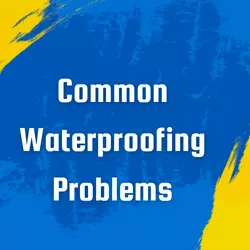What is waterproofing and why is it important?
What is Waterproofing?
Waterproofing is a process used to make a material (usually a surface) resistant to water or moisture. Materials that are waterproofed can often be protected from water damage, including from rain, snow, sleet, and ice. When the material is exposed to water, the water will bead up and roll off the waterproofed surface instead of penetrating and damaging the material.
Waterproofing is essential for a building because it protects the structure from water infiltration and damage. Waterproofing Membranes form a barrier that resists the passage of water, which helps to keep the building dry and protect it from moisture-related damage such as corrosion, peeling, and decay. Additionally, waterproofing can help improve energy efficiency by reducing the amount of moisture that enters the building, which can help to reduce cooling costs.
Types of Waterproofing:
Listed below are some of the most common waterproofing typess used in the construction of buildings.
Cementitious Waterproofing
Cementitious waterproofing method is a type of waterproofing that uses cement as the main waterproofing agent. The cement is mixed with water and other additives and then applied to the surface to be waterproofed. The mixture hardens as it dries, forming a barrier that prevents water from penetrating the surface. This type of waterproofing is most commonly used in areas where water cannot penetrate the substrate, such as roofs and walls.
Liquid Waterproofing Membrane
Liquid waterproofing membrane can be applied in various ways, including with a primer coat, roller, spray or trowel. Liquid waterproofing membrane is a very effective way to waterproof surfaces, and it has many benefits over other methods. One of the benefits of liquid waterproofing membrane is that it can be applied quickly and easily. Additionally, liquid waterproofing membrane can be applied to areas that are difficult to access with other methods.
Bituminous Coating Waterproofing
Bituminous Coating Waterproofing is a technique that uses a bitumen-based coating to waterproof surfaces. The coating is made from a synthetic polymer and has properties that make it flexible and resistant to wear and tear. It can be applied in a variety of ways, including spraying, rolling, or brushing.
The Benefits of Bituminous Coating Waterproofing are many. Primarily, the coating is flexible and can be applied in a number of different ways which makes it less time consuming than some other methods. It also has good protection against water and weather conditions, making it an ideal choice for areas where heavy rain or snowfall is common. One of the main disadvantages of this method is that it does not last as long as other waterproofing options.
Polyurethane Liquid Membrane Waterproofing Method
Polyurethane liquid membrane waterproofing is a very popular method used on flat roofs. It is highly flexible and can be easily applied, but it is expensive. It is most commonly used in areas that are prone to water damage such as flat roofs.
Benefits of waterproofing:
The benefits of waterproofing are numerous. Some of them are listed below.
Improves Structure Durability:
Waterproofing improves the durability of a structure by keeping water from entering and damaging the building’s components. By preventing water from penetrating the building’s walls, roofs, and ceilings, it can prevent costly damage and keep occupants safe. In addition, waterproofing can also help preserve energy by keeping moisture out of air conditioning and heating systems.
Offers Energy Efficiency
Waterproofing can provide energy efficiency by reducing the amount of energy needed to maintain a building or facility. This can be done through a variety of means, such as installing rain gutters and downspouts that direct water away from the building, using insulation and air sealing techniques, and using water repellent coatings.
Reduces Cost of Repairs
Waterproofing a building or structure helps to minimize the cost of repairing damage caused by water infiltration. In general, waterproofing materials and systems can be broadly classified into two categories: impermeable and semi-permeable. Impermeable waterproofing materials block water from entering the system while semi-permeable materials allow water to pass through but can eventually dam up and cause flooding.
Prevents the Onset of Health Concerns
When the roof on your building leaks, water will seep into the structure, causing mold and mildew to grow, and this negatively affects the quality of the air inside your building. For those living in the local vicinity, this could result in wheezing, infection of the eyes, respiratory problems, coughing, and skin irritation due to the potential for air pollution. The onset of the health issues mentioned above can be prevented by getting roof waterproofing completed.
Improves the Life of Interior Work and Furniture
Waterproofing a structure can improve the life of interior work and furniture. This is because waterproofing will protect surfaces from water, dirt, and other debris that may damage the material over time. Additionally, waterproofing can help to maintain an interior environment free from moisture and condensation. This can prolong the life of materials and increase their overall efficiency.





